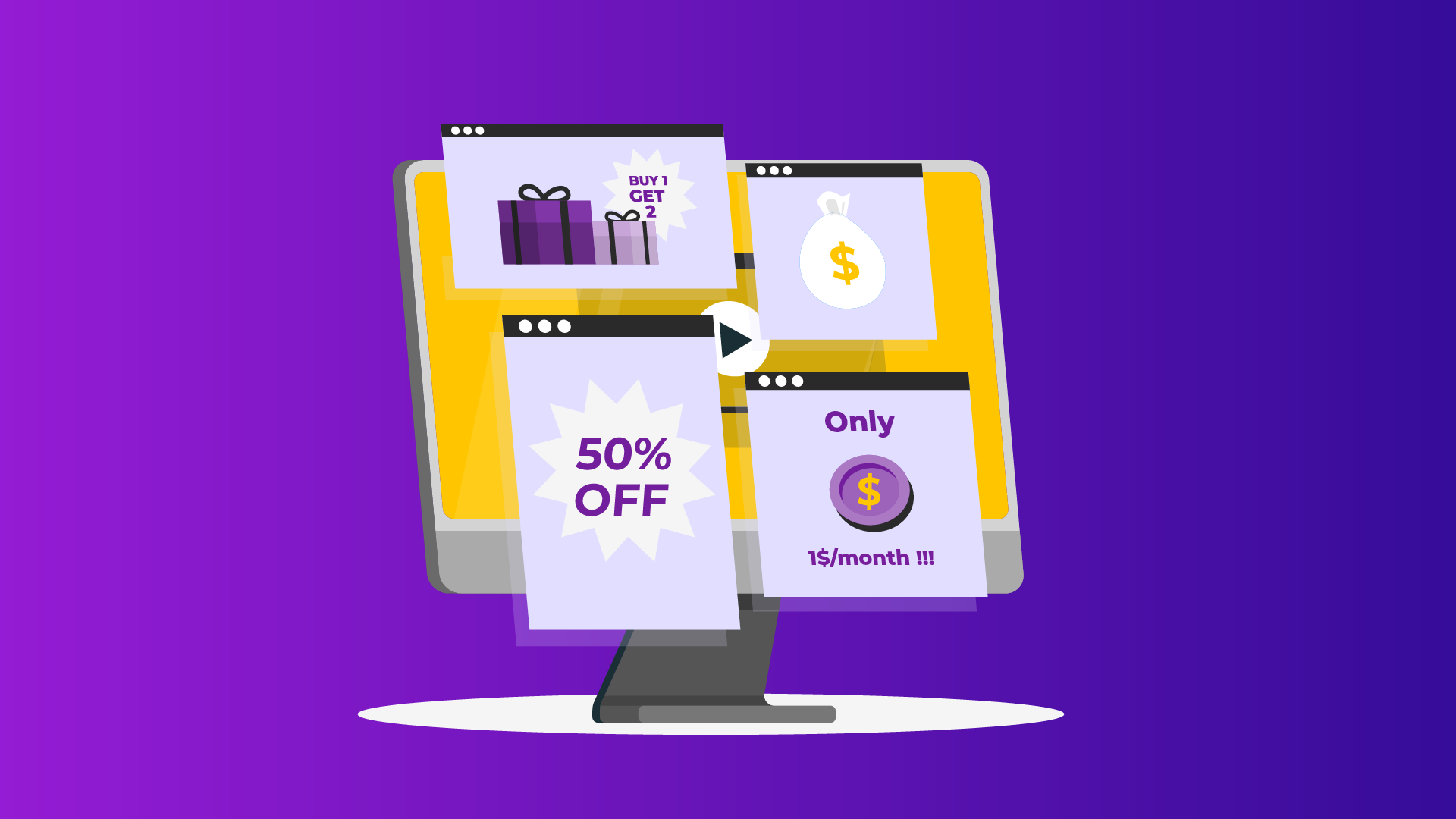Best Ad Banner Sizes to Use
Banner ad sizes have become a pivotal factor in the realm of digital advertising, capturing the attention of publishers, users, and advertisers alike. In the ever-evolving landscape of online marketing, the significance of these dimensions cannot be overstated. But when did banner ad sizes become such a focal point, and why are they so crucial to the success of digital advertising campaigns?
Let’s delve deeper.
What are banner ads?
Banner ads are a form of online advertising that typically consists of a graphical image or animation displayed on a webpage, often with a hyperlink to the advertiser’s website or a specific landing page. These ads are designed to attract the attention of website visitors and encourage them to click through to learn more about a product, service, or offer.
Origin of Banner Ads
Banner ads have their origins in the early days of the Internet, particularly in the 1990s. The concept of digital advertising was still in its infancy, and marketers were exploring ways to monetize the rapidly growing World Wide Web. The idea of using banner-like graphics on webpages to promote products or services was influenced by traditional advertising methods, such as billboards, which are large, eye-catching displays often placed alongside highways and in high-traffic areas.
Why are banner ad sizes important?
Today, banner ad sizes hold a crucial role for all stakeholders in the digital advertising ecosystem. Publishers depend on well-optimized ad dimensions to strike a balance between ads and user experience. Users benefit from unobtrusive, appropriately sized ads that seamlessly blend with their browsing experience, avoiding disruptive interruptions. Advertisers, on the other hand, rely on strategic choices of ad sizes to maximize engagement, click-through rates, and ultimately, return on investment.
Banner ad sizes are critically important in the world of digital advertising for several reasons, all of which are closely tied to driving results and advertising effectiveness:
- Visibility and Attention
The size of a banner ad directly impacts its visibility and ability to grab a user’s attention. Larger ads are more likely to be noticed by users, increasing the chances of capturing their interest.
- User Experience
Well-sized banner ads integrate seamlessly into a webpage’s layout, improving the overall user experience. Ads that are too large or intrusive can disrupt the user’s interaction with the content, leading to negative impressions.
- Engagement
The dimensions of a banner ad affect its click-through rate (CTR) and engagement levels. Larger, well-designed ads tend to have higher CTRs because they provide more space for compelling visuals and messages.
- Compatibility
Websites have designated spaces for ads, and ad sizes need to fit these spaces for proper integration. Using the right ad size ensures compatibility with various web layouts and platforms, preventing display issues.
- Ad Placement
Different ad sizes are suitable for different placements on a webpage. For example, a leaderboard (728×90 pixels) banner might be best for the top of a page, while a medium rectangle (300×250 pixels) might work well within the content. Advertisers must choose sizes that match their placement strategy.
- Page Load Time
Larger ad sizes often have larger file sizes, which can impact page load times. It is one of the 10 most important metrics to track. Slow-loading pages can result in user frustration and increased bounce rates. Optimizing ad sizes and file formats is essential for maintaining fast load times.
- Cost-efficiency
Smaller ad sizes may cost less to produce and may be more cost-effective in terms of impressions and clicks, making them a viable choice for advertisers with budget constraints.
How can publishers and advertisers choose the right banner ad size?
Both publishers and advertisers wield significant influence when it comes to selecting banner ad sizes, a decision that carries distinct advantages for each party. This responsibility should not be taken lightly, as it holds the potential to shape the outcome of their endeavors.
Choosing the right banner ad size is important for publishers to create a successful website monetization strategy. Here are some steps to help publishers choose the right ad sizes.
- Know Your Audience
Analyzing your audience’s device preference is essential. Are they predominantly desktop users, mobile users, or a mix of both? Beyond device preference, understanding user behavior is key. Are they more inclined to scroll through lengthy articles on a desktop or engage in quick, on-the-go browsing on mobile devices? For example, if mobile users tend to engage with short, snackable content, you may want to use smaller ad sizes that complement this format without disrupting the flow.
- Evaluate Your Layout
Consider your website’s layout and design. Identify spaces where ads can be seamlessly integrated without disrupting the flow of content. Larger ad sizes may work well at the top or sides of the page, while smaller sizes can be placed within articles.
- Responsive Design
Given the prevalence of mobile devices, prioritize responsive ad sizes that adapt to various screen sizes. This ensures that ads look good and function correctly on smartphones and tablets.
- Performance Metrics
Analyze your website’s performance metrics, including page load times and bounce rates. Larger ad sizes with heavy graphics can slow down page load times, potentially driving users away. It important to optimize the ad types and ad sizes for fast loading.
- Ad Format Variety
Offer a variety of ad sizes to accommodate different advertiser needs. Providing options like leaderboards, rectangles, and skyscrapers can attract a broader range of advertisers.
- Guidelines and Policies
Establish clear guidelines for advertisers regarding ad sizes, formats, and creative specifications. Ensure that advertisers adhere to these guidelines to maintain a cohesive website appearance.
Choosing the right ad size is essential for advertisers looking to maximize the effectiveness of their campaigns. Here’s how advertisers can make informed decisions about ad sizes:
- Publisher Compatibility
When partnering with supply-side platforms (SSPs) or publishers, it’s crucial to thoroughly review the range of ad sizes they offer. It’s essential to verify that the ad size you intend to use aligns seamlessly with their website layout and the capabilities of their SSP, ensuring a harmonious integration and optimal performance of your advertising campaigns.
- Goals and Objectives
Align your ad size with your campaign objectives. Larger sizes may be better for brand awareness, while smaller sizes may work for direct response campaigns.
- Message and Creatives
Consider the message and creative elements of your ad. Some ad sizes provide more room for storytelling and visuals, while others require concise messaging.
- Responsive Design
Leverage generative AI to create responsive ad creatives that possess the adaptability to seamlessly adjust to a multitude of ad sizes and diverse screen resolutions.
By harnessing the power of generative AI, you can ensure that your ads maintain their visual appeal and effectiveness when viewed on a wide range of devices, offering a consistent and engaging user experience regardless of the platform or screen dimensions.
- Performance Tracking
Implement tracking and analytics to monitor the performance of different ad sizes. Track metrics like click-through rates, conversions, and return on investment (ROI) to assess which sizes deliver the best results.
- A/B Testing
Conduct A/B testing with different ad sizes to determine which ones resonate most with your target audience and lead to the desired actions. Based on that, coordinate with publishers to choose the optimal placement for your ad within their website. The position of your ad can influence its effectiveness.
What are the different banner ad sizes to use?
Banner ad sizes can vary depending on industry standards and the specific goals of an advertising campaign. However, some banner ad sizes have become popular and widely accepted due to their effectiveness and compatibility with a range of website layouts. Here are some of the most common and popular banner ad sizes, along with their benefits, functionality, and purposes:
- Leaderboard (728×90 pixels):
The purpose of the leaderboard ad size (728×90 pixels) is to offer a prominent placement at the top of webpages, making it highly visible, and thus suitable for brand awareness campaigns. It is strategically positioned to establish brand recognition and instantly capture users’ attention upon entering a webpage.
2. Medium Rectangle (300×250 pixels):
The medium rectangle ad size (300×250 pixels) serves a versatile purpose, fitting well within content or sidebars, and is suitable for both branding and direct response campaigns. Its functionality includes accommodating text, images, and interactive elements, effectively promoting products or services while maximizing engagement.
3. Skyscraper (160×600 pixels):
The skyscraper ad size (160×600 pixels) with its tall format provides ample space for creative visuals and messaging, making it effective for brand storytelling. It benefits advertisers by offering an ideal canvas for showcasing products or services with visually appealing graphics and animations, enhancing brand awareness, and conveying comprehensive information.
4. Wide Skyscraper (300×600 pixels):
The wide skyscraper ad size (300×600 pixels), akin to the skyscraper but wider, offers even more room for creative content, making it highly eye-catching. Its purpose lies in effectively engaging users with rich visual storytelling and encouraging interaction. It benefits advertisers by accommodating detailed product descriptions, multiple images, and interactive elements, thus enhancing user engagement and conversion rates.
5. Rectangle (180×150 pixels):
The compact rectangle ad size (180×150 pixels) fits well within the content, providing additional advertising opportunities within articles. Its purpose extends to complementing text content with visual elements or displaying smaller ads. This benefits advertisers by enabling remarketing campaigns, affiliate marketing, or supplementary content promotion while maintaining a non-intrusive user experience.
6. Large Rectangle (336×280 pixels):
The large rectangle ad size (336×280 pixels) offers a larger canvas for ads while still fitting within content, making it excellent for engagement and conversions. Its purpose is to effectively encourage user interaction, such as clicks, sign-ups, or purchases. This benefits advertisers by providing ample space for compelling visuals, call-to-action buttons, and interactive elements, thus optimizing campaign effectiveness.
7. Mobile Leaderboard (320×50 pixels):
The mobile leaderboard ad size (320×50 pixels) is designed for mobile screens, ensuring optimal visibility on smartphones. Its purpose lies in capturing mobile users’ attention and driving mobile-specific actions, benefiting advertisers by effectively reaching the mobile audience for both brand awareness and direct response campaigns.
8. Billboard (970×250 pixels):
The billboard ad size (970×250 pixels) offers a large, impactful ad space suitable for visually striking creatives, creating a strong brand presence. Its purpose includes showcasing premium products, video content, or high-impact visuals, benefiting advertisers by delivering premium brand campaigns and making a bold visual statement to engage the audience effectively.
9. YouTube Banner Ad Size:
YouTube banners are used to create a visually appealing channel identity and showcase your brand or content theme to viewers.
The YouTube banner size, also known as the channel cover photo, is 2560 x 1440 pixels. This size allows for creative designs and branding elements. It’s an excellent canvas for incorporating your channel name, logo, and tagline for immediate recognition. Regularly updating your banner is essential for promoting current content, events, or collaborations, keeping your channel engaging and relevant.
10. Twitter Banner Ad Size (Header Image):
Twitter banner ads, also known as header images, enhance your profile’s visual appeal and professionalism, allowing you to convey your personality or brand message effectively.
The recommended Twitter banner size is 1500 x 500 pixels. This provides a wide canvas for creative expression. It’s ideal for showcasing your personality, interests, or brand identity. Regularly changing your header image to reflect promotions, campaigns, or events ensures your Twitter profile remains dynamic and engaging.
11. Facebook Banner Ad Size (Cover Photo):
Facebook banner ads, or cover photos, offer an inviting and informative introduction to your Facebook profile or page, establishing credibility and encouraging visitors to explore your content or offerings.
The Facebook cover photo size is 820 x 312 pixels, with mobile display dimensions of 640 x 360 pixels. This size allows for a detailed, high-quality image that can incorporate branding elements, product images, or key messages. Frequent updates to the cover photo help highlight seasonal events, offers, or announcements, ensuring your Facebook presence remains engaging.
When choosing banner ad sizes, it’s essential to consider the campaign’s objectives, target audience, and the specific layout of the publisher’s website. Selecting the right size based on these factors can greatly enhance the effectiveness of your advertising efforts.
What are the benefits of using the right banner ad size?
Using the right banner ad size in advertising offers a range of benefits that can significantly impact the success of your advertising campaigns. Here are some of the key advantages:
- Increased Engagement
Banner sizes that align with best practices offer more space for creative messaging and compelling visuals. This allows for more engaging and interactive ad content, increasing the chances of user engagement and interaction with your brand.
- Higher Conversions
A properly sized banner is more likely to secure a higher Click-Through Rate (CTR) as users are enticed to engage with it, generating more clicks and impressions.
Furthermore, the additional space for compelling visuals and interactive content fosters increased user engagement and extended interaction times, while simultaneously reducing bounce rates.
Such well-crafted ads, which enhance brand recall and message retention, ultimately contribute to higher conversion rates, making users more likely to take the desired action, whether that’s making a purchase, signing up, or downloading an app.
- Mobile-friendly
In an era of expanding mobile device usage, selecting the appropriate banner size for mobile platforms becomes imperative. Mobile-friendly banners, when sized correctly, guarantee that your ads maintain their visual appeal and operational excellence on smartphones and tablets, extending your reach to a wider and more diverse audience.
- Data-Driven Insights
When you use the right banner size, it becomes easier to analyze and interpret performance metrics. You can gain insights into which sizes work best for your target audience, allowing for data-driven decisions and campaign optimization.
- Competitive Advantage
Advertisers who take the time to select the right banner ad sizes gain a competitive advantage. Your ads are more likely to stand out and deliver better results compared to competitors who use poorly sized or intrusive ads.
- Combat ad blockers
Addressing ad blockers with banner ads necessitates a multifaceted strategy that balances user preferences with the need for effective advertising. Begin by crafting non-intrusive banner ads that seamlessly integrate into website content and design.
Adhering to acceptable ad standards and embracing native advertising can mitigate the risk of ad blocking. Continuous testing and ethical advertising practices further reinforce this approach, helping to navigate the challenges presented by ad blockers and walled garden ecosystems, all while maintaining a sustainable advertising environment.
By embracing non-intrusive, user-centric advertising practices and optimizing banner ad sizes for enhanced user experiences, you can navigate and thrive in the changing ad tech ecosystem. maintain transparency, adhere to ethical advertising practices in the cookieless world, and continuously adapt user-centric strategies to strike the delicate balance between audience engagement and respecting user preferences. As we move forward, the key lies in fostering trust, embracing innovation, and evolving with the ever-changing digital landscape, ultimately securing the future of banner advertising in the online realm.




Leave a Reply